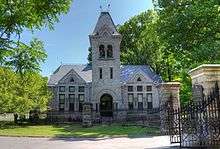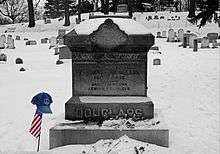Mount Hope Cemetery (Rochester)
 Gate House of Mount Hope Cemetery | |
 Location within New York State  Location within United States | |
| Details | |
|---|---|
| Established | 1838 |
| Location | Rochester, New York |
| Country | USA |
| Coordinates | 43°07′40″N 77°36′59″W / 43.127763°N 77.616265°WCoordinates: 43°07′40″N 77°36′59″W / 43.127763°N 77.616265°W |
| Type | public |
| Owned by | City of Rochester |
| Size | 196 acres (79 ha) |
| No. of graves | 350,000 |
| Find a Grave | Mount Hope Cemetery |
| The Political Graveyard | Mount Hope Cemetery |
|
Mount Hope Cemetery | |
| NRHP reference # | 100002361 |
| Added to NRHP | April 30, 2018 |
Mount Hope Cemetery in Rochester, New York, founded in 1838, is the first municipal rural cemeteries in the United States'. Situated on 196 acres (79 ha) of land adjacent to the University of Rochester on Mount Hope Avenue, the cemetery is the permanent resting place of over 350,000 people. The annual growth rate of this cemetery is 500-600 burials per year.
The cemetery hosts the sculpture Defenders of the Flag, a Civil War monument made in 1908 by the American sculptor Sally James Farnham. In 2018 it was listed on the National Register of Historic Places.[1]
Geology of Mount Hope
About 12,000 to 14,000 years ago, Mount Hope was covered with ice one to two miles thick. As the glacier receded, cracks appeared in the ice, and these crevasses became rivers of water and gravel. When the miles-high ice sheets finally melted, these river beds were left as ridges created from all the rock and rubble that had been deposited by the flowing river. In geological terms, these ridges are called eskers. One such esker snakes its way through much of Mount Hope Cemetery.
The Seneca Indians used the Mount Hope esker as a trail from the Bristol Hills south of Rochester to Lake Ontario on the city's northern border. For the Senecas, it provided a continuous high path through the moraine and visibility of valleys around them. Today, this esker is a principal vehicular lane through the cemetery and is called Indian Trail Avenue.
_01.jpg)

_04.jpg)
Notable Structures and Events
Mt. Hope Cemetery was once the site of "The Fandango Tower." This was a wooden structure, sitting atop the highest elevation of the cemetery, acting as an observation tower. This offered visitors grand views of the city, as well as the meandering Genesee River. The Fandango was involved in the "Great Rochester Mirage" of April, 1871. Visitors to the tower noted on the morning of April 16th, 1871 that views of the Canadian banks of Lake Ontario could be seen from the tower in great detail, as if replacing those of Rochester. These views of Canada's lake shores, over 50 miles away, were indeed visible from The Fandango Tower, due to an atmospheric phenomena known as Fata Morgana. The Fandango Tower is no more, however the ruined foundations can still be found in one of the deep kettles of the cemetery to this day.
The architectural styles of the cemetery's gravestone and grave markers, crypts, chapels, gatehouses, and mausoleums span three centuries. Distinct motifs of the High Victorian Gothic and Neoclassical architectural traditions persist throughout the cemetery and its various structures. Tiffany glass windows may be found in several of the mausoleums.
The cemetery is home to several working water features. Sylvan Waters, a water feature constructed within a naturally forming kettle pond, was remodeled and brought back into use during the Fall-Winter season of 2016 and 2017.
In June 2000, American Civil War General Elisha G. Marshall's crypt was desecrated and vandalized, resulting in his remains being scattered throughout the surrounding area. Marshall's bodily remains were gathered and reinterred, however the whereabouts of the skull remains a mystery. The perpetrators were never apprehended or identified.
Notable burials
- Samuel G. Andrews
- Susan B. Anthony
- Charles S. Baker
- John Jacob Bausch
- Hartwell Carver
- Jonathan Child
- Emma Lampert Cooper
- Adelaide Crapsey
- Algernon Crapsey
- Frederick Douglass
- Thomas B. Dunn
- George Ellwanger
- Frank Gannett
- Malcolm Glazer
- Morton Goldberg
- Seth Green
- James Hard
- Myron Holley
- Ray P. Hylan
- Thomas Kempshall
- Henry Lomb
- General E.G. Marshall
- Vincent Mathews
- Lewis Henry Morgan
- Anna Murray-Douglass
- Henry O'Reilly
- Amy and Isaac Post
- Charles Mulford Robinson
- Nathaniel Rochester
- Thomas H. Rochester
- Abraham M. Schermerhorn
- George B. Selden
- Henry R. Selden
- Hiram Sibley
- Elijah F. Smith
- Fletcher Steele
- Margaret Woodbury Strong
- Theron R. Strong
- Samuel R. Thayer
- Lillian Wald
- Henry Augustus Ward
- Don Alonzo Watson
- Jessica M. Weis
- George Whipple
- Frederick Whittlesey
- Abel Carter Wilder
General Elwell Stephen Otis was originally interred at Mount Hope before being removed to Arlington National Cemetery. Notable cremations at Mount Hope include Blanche Stuart Scott and George Eastman.
Friends of Mount Hope
The Friends of Mount Hope Cemetery is a non-profit organization of volunteers founded in 1980 to restore, preserve, and encourage public use and enjoyment of this unique historical treasure.
See also
References
- ↑ "National Register of Historic Places actions for May 4, 2018". U.S. National Park Service. May 4, 2018. Retrieved May 13, 2018.
Further reading
External links
| Wikimedia Commons has media related to Mount Hope Cemetery (Rochester). |


